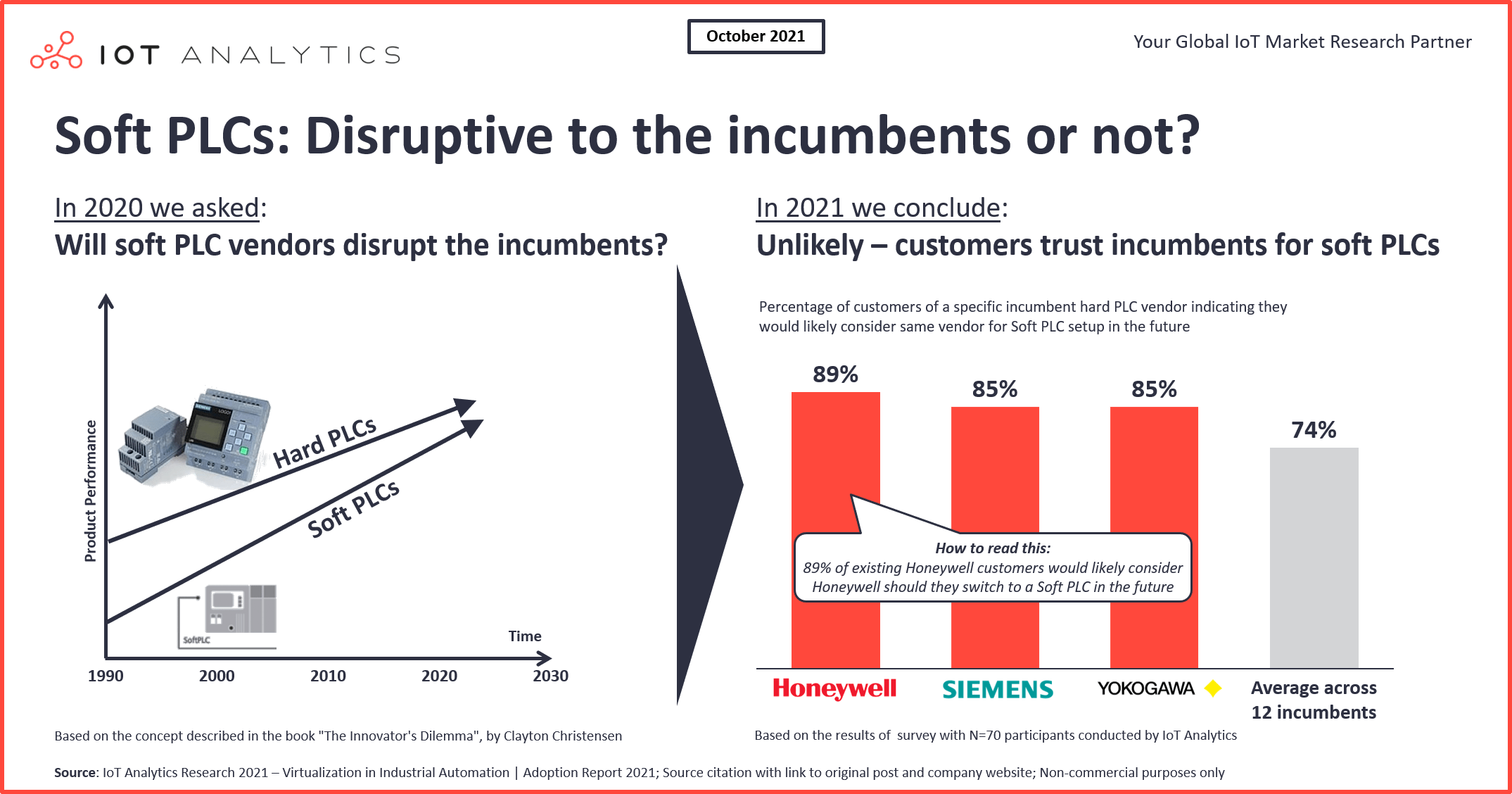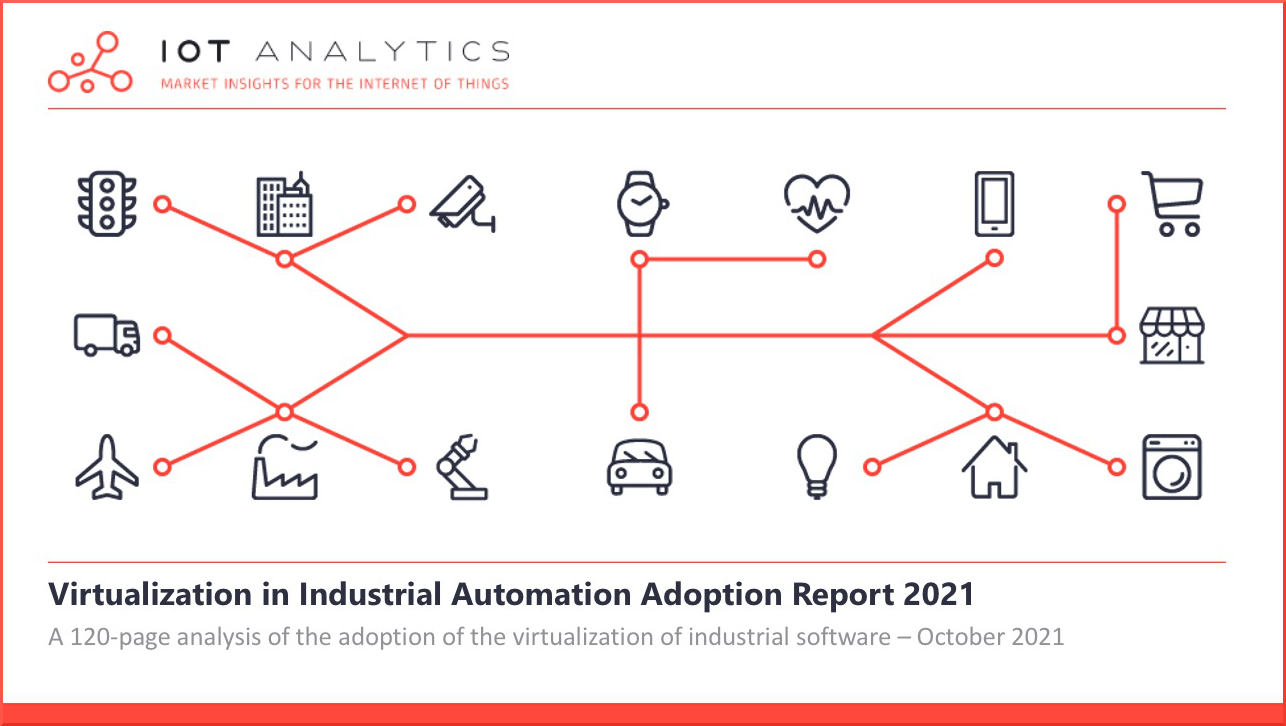
In short
- Software based PLCs (programmable logic controllers) may pose an innovator’s dilemma to the incumbents of the industrial automation world and threaten their hard-PLC business.
- Our most recent research on the topic shows that the threat of disruption for incumbent vendors is lower than previously assumed because customers are indicating that they would stick to existing vendors for soft-PLC setups.
Why it matters?
- The promise of virtualized workloads (specifically, software based PLCs) is real and will likely change how operators automate their production lines, buildings, or similar spaces in the future.
- Industrial automation vendors are looking to protect their core control systems business and need to keep an eye on important substitution threats, such as Soft PLCs.
Revisiting our 2020 research on software based PLCs
In December 2020, we published a widely read article titled “Soft PLCs: The industrial innovator’s dilemma.” In it, we argued that the rise of software based PLCs in the industrial world can be compared to the rise of digital cameras in photography and represents a potential innovator’s dilemma for incumbents similar to the infamous Kodak example.
This month, we published a follow-up research report titled: “Virtualization in Industrial Automation: Adoption Report 2021.” For this report, we interviewed 70 global c-level operational technology (OT) executives in various manufacturing companies to understand their views on virtualization in the broader context of industrial automation, and specifically on soft PLCs.
“The promise of virtual and software based PLCs is clearly resonating with potential end-users“
Our new research suggests that the promise of virtual and soft PLCs is clearly resonating with potential end-users. Interestingly, however, the research also shows that industrial end users have a preference to buy soft PLCs from existing hard-PLC vendors, thereby altering our idea of the industry potentially being open to disruption by new entrants. Soft-PLC vendors would remain the innovators, but their chances of disrupting the majority of the market now seem lower.
The big picture: companies are digitizing their industrial automation setups
With 75% of interviewed companies having a dedicated digitalization strategy, modernizing existing industrial automation setups is clearly in the focus of most manufacturers. In fact, according to our survey, one-third of the automation budget is now being dedicated to digitalization activities. This includes themes such as connecting disparate assets, performing data visualization and analytics, upgrading control systems to meet enhanced data needs, and modernizing equipment and software, among others.
Selected quotes from OT decision makers on their digitalization strategy
“We are bridging the gap between the operations of various departments. For example, we fully digitalised design & operations work to include project management, material handling, compliance and certification, operations, maintenance and procurement systems, cost control, planning and reporting.”
Director of Operations at an Oil&Gas company in the USA
“We have an Industry 4.0 roadmap, which is only 30% completed. Our strategy is to integrate all of our production tools to drive up tool utilisation levels (real-time detection of events), increase productivity (tied to our MES and ERP systems), and AI (building a large database of product-related data).”
VP Operations at an electronics manufacturing company in the USA
The virtualization of automation workloads is another key theme for industrial companies today. Virtualization decouples hardware from software and allows the workloads to be executed in a distributed fashion from the cloud all the way to the far edge. According to our research, 60% of companies have already virtualized some of their storage, visualization, supervisory control and data acquisition (SCADA), or control workloads. Although the virtualization of PLCs (i.e., the introduction of software-based PLCs) is not yet the top priority for most of the manufacturers, they are aware that it is an option and are considering control workload virtualization via software based PLCs. The move towards virtualized control workloads has certainly begun.
Soft PLCs: Sticking to familiar vendors
| Definition of soft PLC
Soft PLC (or software based PLC) = A control system setup in which the control logic software is partially or fully decoupled from the PLC hardware, thus enabling the software to perform the execution of control logic workloads (e.g., the command for shutting or opening a valve) on different pieces of hardware.
| Definition of virtualized PLC
Virtualized PLC = A soft PLC that is deployed in a virtualized computing environment (i.e., on top a of hypervisor).
In our interviews, 74% of respondents say they would likely or very likely consider their existing hard-PLC vendor for a future soft-PLC/virtualized control setup. Thus, it was unsurprising that the vendors most mentioned included the current market leaders for hard PLCs, such as Siemens, Rockwell Automation, and ABB.
The three standout companies from our interview set are Honeywell, with 89% of their customers likely to consider their soft PLCs in the future, and Yokogawa and Siemens (both at 85%).
Why the preference for existing vendors?
The clear number-one decision-making criteria when purchasing virtualized or software based controllers is that they need to guarantee high availability, with extremely high uptime and low mean time between failures. This is so important because the downtime of a controller may lead to the production stop of an entire factory which can cost millions of USD in a matter of minutes.
Cybersecurity practices, and the ability of an in-house team to maintain the system, are also important decision-making criteria.
Incumbent vendors have mostly already proven that they satisfy these criteria with their existing automation systems, and hence their solutions are perceived to have a higher level of trustworthiness when compared to new players in the market (or a combination of commoditized hardware and PLC software).
Vendors are positioning themselves for the future
While a truly hardware-agnostic software based PLC offering is yet to be presented by any of the large incumbent players, incremental steps are being taken in this direction to “test the water.”
Examples include:
- Rockwell’s latest Emulation software for the Control Logix 5580 (link) allows the user to develop and test control codes in a completely virtual environment without any hardware.
- Siemens expanded its edge offering with the introduction of the Industrial Edge v1.0 platform (link), capable of device management, edge apps, and remote software upgrades even for edge devices with container (Docker)-based runtimes.
Schneider Electric also seems to have taken clues from the market with the latest launch of its software-centric industrial automation system, EcoStruxure Automation Expert platform (link), under its Universal Automation portfolio. Based on the IEC 61499 standard, Automation Expert sets the stage for open, portable, and reliable automation. Automation Expert enables its users to fully decouple control hardware and software, allowing control logic to execute in the edge and in the cloud (link).
These examples show that the incumbent players are active and are evolving their systems towards more modular and virtualized setups of the future.
Conclusion & Outlook – The customer beckons
As we revisit what we called the industrial innovators dilemma, we no longer think that it represents an actual innovator’s dilemma. Incumbent vendors are ready, and customers are willing to work with them. At the same time, there are also market innovators (we highlighted Beckhoff and Codesys as two interesting examples in our last analysis; another one is Austria-based Logi.cals) that are likely to gain more traction in the near future.
Our latest research shows that manufacturers are actively digitizing and virtualizing their industrial automation systems. In addition to control logic, other workloads such as storage, visualization, and SCADA, are also being virtualized rapidly.
Our research further suggests that industrial automation vendors do not need to be afraid of margin dilution when introducing virtualized or soft PLCs. In fact, some manufacturers have indicated that they would be willing to pay more for their soft PLCs compared to their hard PLC setup because of the promise of additional cost savings in system maintenance and potentially higher reliability.
More information and further reading
Are you interested in learning more about Virtualization in Industrial Automation?
The Virtualization on Industrial Automation Adoption Report 2021 is a comprehensive 120-page report analyzing the adoption of virtualization in industrial automation including trends and challenges of OT virtualization along the ISA 95 automation pyramid (1. In general, 2. Control infrastructure & systems, and 3. Controllers & PLCs).
It is part of IoT Analytics’ ongoing coverage of Industrial IoT and Industry 4.0 (Industrial IoT Research Workstream)

This report provides answers to the following questions (among others):
- How are automation systems effected as companies digitize their manufacturing/operations?
- Which software workloads have companies currently virtualized and which software workloads are planned to be virtualized in the near future?
- Do companies have comprehensive digitalization strategies and how do they impact the management of automation systems?
- How do companies procure automation software today, and in three years?
- Which operating systems are companies using for real-time virtual controllers?
- What are the most important decision-making factors when choosing a vendor for virtualized PLCs?
- How much are companies willing to pay for virtual PLCs compared to legacy PLCs?
- Do companies have a global standard for PLC/DCS vendors?
- Which vendors are companies using today and how likely is it that they are considered for virtual PLC setups in the future?
And more …
Sample
The sample of the report gives you a holistic overview of the available analysis (outline, key slides). The sample also provides additional context on the topic and describes the methodology of the analysis. You can download the sample here:
Related articles
- Soft PLCs: The industrial innovator’s dilemma
- The top 10 IoT Use Cases
- IoT integrators: The secret backbone of the IoT – Insights from 700+ companies providing professional IoT services
- What are smart factories? 7 misconceptions and a definition
- IoT edge computing – what it is and how it is becoming more intelligent
Are you interested in continued IoT coverage and updates?
Subscribe to our newsletter and follow us on LinkedIn and Twitter to stay up-to-date on the latest trends shaping the IoT markets. For complete enterprise IoT coverage with access to all of IoT Analytics’ paid content & reports including dedicated analyst time check out Enterprise subscription.

